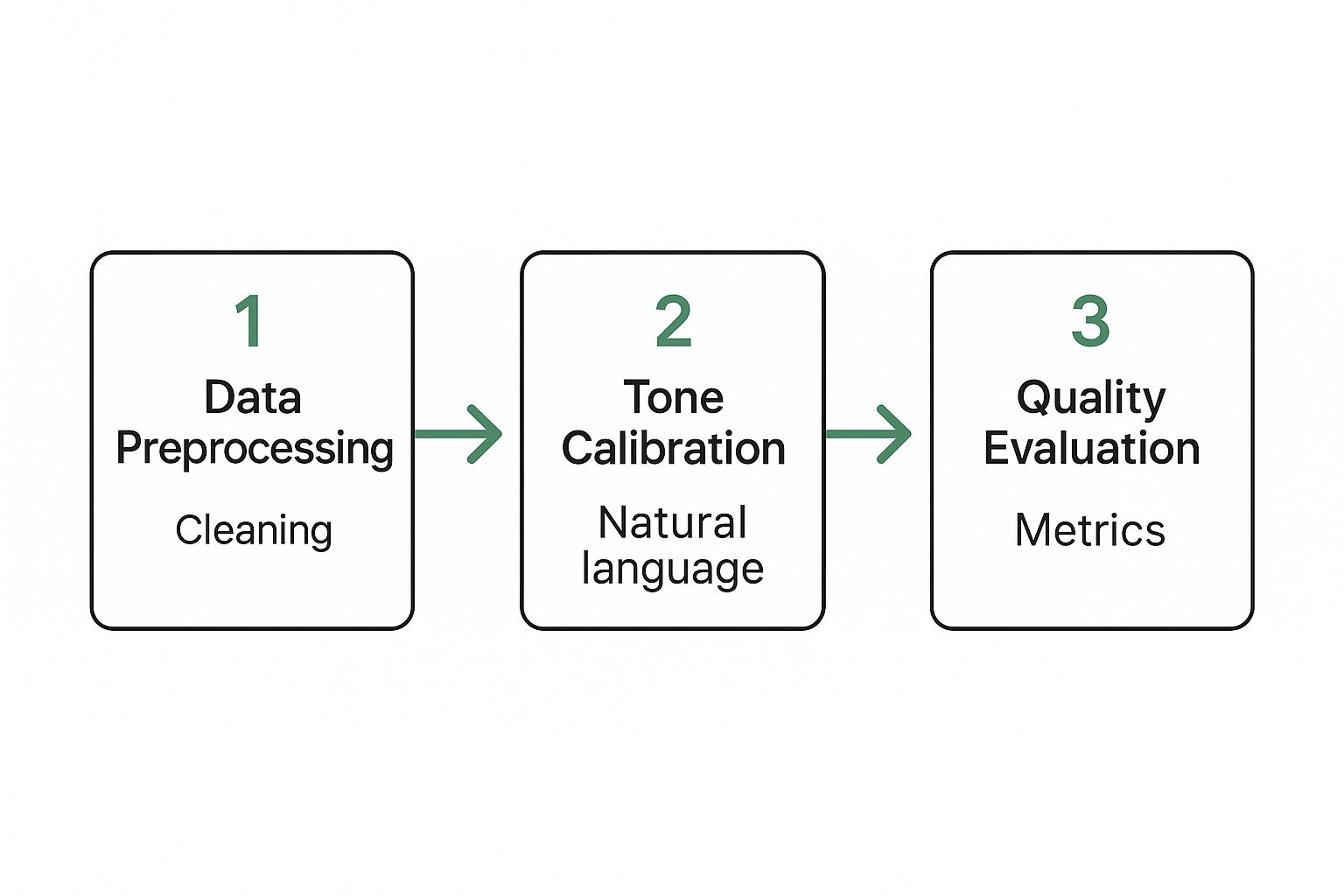
What Is an AI Text Humanizer?
August 15, 2025
An AI text humanizer is a tool that takes AI-generated content and gives it a do-over, making it sound more natural and authentic. The whole point is to rewrite text that feels robotic so it becomes completely indistinguishable from something a person wrote. This helps it connect with actual readers and, just as importantly, sail past AI detectors.
The Problem with Robotic AI Content

In the rush to get content out the door, AI writing tools have become a go-to for creators everywhere. They can spit out a draft in seconds, outline a tricky topic, and help you smash through writer's block. But that speed often comes with a hidden cost: the content can feel sterile, predictable, and totally lacking in personality.
This leaves modern writers, marketers, and students with a real challenge. How do you keep up the pace and volume that AI makes possible without losing the genuine voice that builds trust with an audience? The output from these models, as good as it is, often carries subtle but distinct digital fingerprints.
Identifying the AI Footprint
AI-generated text has a habit of falling into patterns that just feel a bit off to a human reader. These are the exact giveaways that sophisticated AI detectors are trained to spot.
The most common signs include:
- Uniform Sentence Structure: AI loves using sentences of similar length and structure over and over, which creates a really monotonous rhythm.
- Overly Formal Tone: The writing can sound like an academic paper or a stuffy instruction manual, missing the casual, conversational flow of how people actually talk.
- Lack of Nuance: It often misses the subtle emotional cues, humor, or cultural context that a human writer would weave in without even thinking about it.
- Repetitive Word Choices: Unless you prompt it very carefully, an AI model can get stuck on certain words and phrases, making the whole piece feel formulaic.
The core issue isn't just about getting the grammar or facts right; it's about connection. Robotic text fails to grab readers on an emotional level. It's forgettable, and it's far less effective at persuading, informing, or entertaining anyone.
To really get a handle on these challenges, it helps to understand the mechanics behind it all, like how to use AI to write a book and what that means for the final quality. This is exactly where an AI text humanizer becomes such a vital tool. It’s that crucial last step that turns a functional but lifeless draft into something that actually resonates with people.
How an AI Text Humanizer Actually Works
Think of an AI text humanizer as an expert editor who doesn't just catch typos but completely reimagines your text's personality. It’s not just swapping out a few words here and there. Instead, these tools perform a deep analysis of AI-generated content, looking for the digital fingerprints left behind by language models.
This is a much more sophisticated process than a simple find-and-replace. The humanizer’s algorithm is trained on massive datasets of genuine human writing, so it knows what makes text feel authentic. It spots common AI giveaways, like predictable sentence structures, a flat tone, and a monotonous rhythm.
Deconstructing and Rebuilding Text
Once the tool analyzes the text, it starts a clever rebuilding process. It doesn't just edit—it restructures from the ground up. This involves a few key moves to give the writing a more human-like feel.
Here’s what’s happening behind the scenes:
- Varying Sentence Length and Structure: It breaks up long, uniform sentences, mixing in short, punchy statements with longer, more descriptive ones to create a natural rhythm.
- Improving Lexical Diversity: The tool gets rid of overused or generic words, replacing them with more specific and engaging language.
- Injecting Idiomatic Expressions: It might weave in common phrases, colloquialisms, or turns of phrase that a native speaker would use without thinking twice.
- Adjusting the Rhythm and Flow: By tweaking punctuation and sentence construction, it creates a conversational cadence that’s just easier and more enjoyable to read.
An AI text humanizer essentially teaches a robot to write with a bit of style. It moves beyond the logical, pattern-based output of a standard AI and introduces the slight imperfections and creative flair that define human expression.
From Robotic to Realistic: A Quick Comparison
To really see the difference, let’s look at a simple before-and-after. This table shows how a bland, AI-generated sentence can be transformed into something far more authentic and persuasive.
AI-Generated Text vs Humanized Text: A Quick Comparison
| Characteristic | Standard AI-Generated Text | Humanized Text |
|---|---|---|
| Original Sentence | The utilization of this software will result in the optimization of your workflow efficiency. | This software will completely overhaul your workflow and make you more efficient. |
| Tone | Overly formal and passive. | Direct, active, and conversational. |
| Word Choice | Uses jargon like "utilization" and "optimization." | Employs simpler, stronger words like "overhaul" and "efficient." |
| Human Feel | Feels distant and robotic. | Sounds like a recommendation from a real person. |
This shift from a stiff, predictable structure to one that’s dynamic and engaging is exactly what an AI text humanizer is built to do. It’s not about tricking anyone—it’s about making the content genuinely better and more effective for the people you want to reach.
So, Why Bother Humanizing Your AI Content?

It's easy to think of humanizing AI drafts as a final, optional touch-up. But it’s not just a "nice-to-have" anymore. For anyone serious about creating content that actually works, using an AI text humanizer is a must.
The reasons aren't just about style; they're about survival and success online.
One of the biggest motivations is the rise of AI detection. Search engines like Google, not to mention schools and other platforms, are getting much better at spotting machine-generated text. Content that gets flagged can be downranked or just plain ignored. Humanizing is your best defense.
Make a Real Connection with Your Audience
Beyond avoiding penalties, there's a much simpler reason to humanize your text: people like reading things written by people.
Think about the last article you truly enjoyed. It probably had a unique voice and a personality that made you feel like you were connecting with a real person, right?
Raw AI content just doesn't have that spark. It can feel cold, generic, and a bit sterile, which is a surefire way to make your readers tune out.
- It builds trust. Writing that feels authentic helps you build a stronger bond with your audience. They're more likely to believe what you have to say.
- It’s just easier to read. A natural flow and varied sentence structures make your content more enjoyable and less of a chore to get through.
- It keeps people hooked. When your content is genuinely engaging, readers stick around, absorb your message, and actually want to come back for more.
For a closer look at the nuts and bolts, we have a whole guide on https://naturalwrite.com/blog/how-to-humanize-ai-text that's packed with practical steps.
Humanized text turns a lecture into a conversation. It’s the difference between reading a textbook and talking to a smart friend—one gives you facts, but the other actually resonates.
Give Your SEO a Serious Boost
Finally, let's talk about SEO. Search engines are constantly getting smarter, and their main goal is to show people content that is genuinely helpful and valuable. Generic, cookie-cutter articles churned out by AI rarely fit that bill.
When you humanize your content, you're injecting the personality, unique insights, and stylistic flair that algorithms are now smart enough to recognize and reward. This isn't just about avoiding penalties for "thin" content; it's about actively improving your chances of ranking.
For businesses relying on content, ensuring it's human-centric is a core part of modern AI-powered SEO strategies. At the end of the day, high-quality content written for humans is the foundation of any SEO effort that stands the test of time.
Choosing the Right AI Text Humanizer
With so many options out there, picking the best AI text humanizer can feel a bit overwhelming. But not all of these tools are created equal. The right choice really depends on what you need it for—from the kind of content you’re creating to the level of polish you’re after.
Making a smart decision means looking past the flashy marketing claims and zeroing in on what actually matters. Think of it like picking a tool from a toolbox. A hammer is great for nails, but you wouldn’t use it to tighten a screw. In the same way, a humanizer built for academic papers probably won’t have the right touch for punchy marketing copy.
Core Features to Look For
To find your perfect fit, it helps to measure each tool against a few key criteria. These are the things that will directly impact the quality of your final text and how much time you save.
Here’s what you should be evaluating:
- Output Quality and Naturalness: Does the rewritten text actually sound human? You’re looking for a tool that produces smooth, engaging content without clunky phrasing or weird logical jumps.
- AI Detection Bypass Rate: Let's be honest, this is a big reason you're here. Check for tools that have a proven high success rate against the big detectors like Turnitin and GPTZero.
- Variety of Tones and Styles: A great humanizer gives you options. Can it flip between formal, casual, professional, or creative tones to match what you're writing?
- Ease of Use: The process should be simple. An intuitive interface with a one-click process, like the one Natural Write offers, is a huge time-saver.
A top-tier AI text humanizer doesn't just swap out words; it understands context. It should keep your original meaning intact while completely transforming the structure and voice of the text.
Comparing Your Options
The market for these tools is growing fast, and each one brings something different to the table. As of 2025, you can really see how the technology has evolved to serve different kinds of writers and creators.
For example, some tools have free plans with word limits, perfect for quick social media posts or marketing blurbs. They often support multiple languages and tones, from friendly to professional, though the free versions usually cap how much text you can process at once.
Other platforms are more focused on collaborative features for teams or deep sentence restructuring for a more formal tone. This diversity shows the market is maturing, which is great for us. It means you can find an AI text humanizer that fits your specific needs for style, tone, and complexity, helping you create undetectable, human-sounding text. If you want a deeper dive, you can explore more insights on the best AI humanizers available.
Ultimately, the best choice aligns with your content goals. Are you looking for a tool for quick email touch-ups, or do you need something to refine long-form articles? Answering that question is the first step to finding the right partner in your writing process.
Feature Comparison of Top AI Humanizer Tools
Here's a side-by-side look at some of the leading AI humanizers to help you choose the best fit for your content needs.
| Feature | Natural Write (Featured) | Tool B (Balanced) | Tool C (Academic Focus) |
|---|---|---|---|
| Primary Use Case | Marketing, blogging, general content creation | Social media, short-form content | Essays, research papers, formal documents |
| AI Detection Bypass | High success rate against all major detectors | Good, but may require minor edits for some detectors | Excellent for academic detectors like Turnitin |
| Tone & Style Options | Extensive (casual, professional, witty, persuasive, etc.) | Limited (friendly, professional, formal) | Focused on academic and formal tones |
| Ease of Use | One-click humanization, very intuitive | Simple interface, good for beginners | More complex with advanced grammar and syntax controls |
| Free Plan | Yes, with a generous daily word limit | Yes, with a lower word limit per submission | Limited free trial or demo version |
| Best For | Creators who need versatility and high-quality output | Users needing quick, simple humanization for short text | Students and academics requiring undetectable essays |
As you can see, the "best" tool really depends on the job. While some are great all-rounders, others excel in specific areas. Picking the one that matches your workflow is key.
Weaving Humanization into Your Content Workflow
Using an AI text humanizer well isn't about replacing your creative process—it's about upgrading it. Think of it as adding a finishing expert to your content assembly line. When you slot it in correctly, you keep your speed without losing that authentic touch your audience expects.
The most effective way to do this is with a simple, three-step workflow. This approach treats AI as a powerful assistant that does the heavy lifting (the initial draft), leaving the final, crucial polish to you.
The Three-Step Humanization Process
First, get your initial draft from a primary AI writer like ChatGPT. The goal here is just to get the core information, structure, and key points onto the page. Don't sweat the prose at this stage; you're just building a solid foundation to work from.
Next, run that draft through a quality AI text humanizer. This is where the real transformation happens. The tool will tackle robotic sentences, smooth out the flow, and add the kind of stylistic variety that makes writing feel human. This step is all about refining the text to make it natural and engaging. Our guide on how to rewrite AI text for better results dives deeper into this part of the process.
Finally, give it a quick human review. This last pass is your chance to layer in brand-specific language, double-check for contextual accuracy, and make sure the tone is a perfect match for your audience. The tool does most of the work, but your final seal of approval ensures it’s just right.
This infographic shows a similar process, illustrating how raw output is calibrated for tone and then checked for quality.

As you can see, getting that natural tone isn't a single click. It's a deliberate, multi-stage process.
This kind of workflow is quickly becoming the norm. The latest data shows that 90% of content marketers have already brought AI into their process, and 41% say they've seen a major efficiency boost by refining AI drafts with tools like humanizers. It’s clear these tools are no longer a novelty; they’re an essential part of a modern content strategy.
Common Questions About AI Text Humanizers

As you start exploring AI text humanizers, it’s normal to have a few questions pop up. Getting them answered upfront helps you use these tools with confidence and get the results you’re looking for.
Let's clear up some of the most common ones.
Is Using an AI Text Humanizer Plagiarism?
In short, no. Plagiarism means passing off someone else's original work as your own. An AI humanizer does the opposite: it rewrites and restructures your draft to create a new, unique version.
Of course, in academic settings, the rules are different. It's always on you to make sure your submission is genuinely original and that you've cited all your research sources properly.
Can Humanizers Bypass Every Single AI Detector?
While the best humanizers have an incredibly high success rate against the big-name detectors, no tool can honestly promise a 100% guarantee. Why? Because AI detection technology is always changing and getting smarter.
The real goal of an AI text humanizer is to make your content statistically identical to human writing. This dramatically lowers the odds of it ever getting flagged. To dig deeper into this, check out our guide on how to bypass AI detection the right way.
Do I Still Need to Edit the Final Text?
Yes, absolutely. A final once-over from a human is non-negotiable. Think of the AI text humanizer as a brilliant assistant that does about 95% of the heavy lifting for you.
That last 5% is where you come in. It’s your chance to catch any tiny contextual quirks, make sure the tone perfectly fits your brand, and add that final layer of personal polish that makes the content truly yours.
Ready to turn your AI drafts into authentic, engaging content that connects with readers? Try Natural Write today and see just how easy it is to get that perfect human touch with a single click. Visit https://naturalwrite.com to get started for free.


